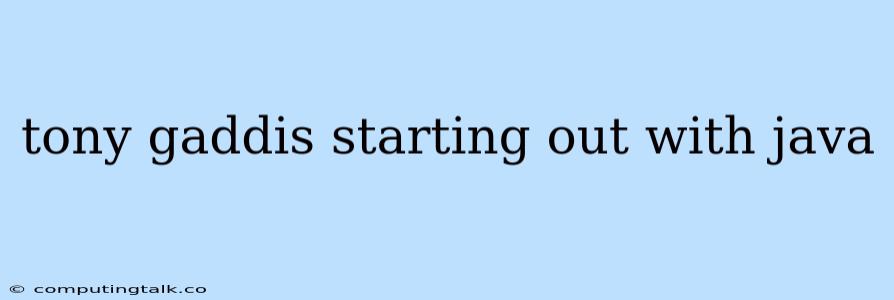Embark on Your Java Journey with Tony Gaddis' "Starting Out with Java"
Tony Gaddis' "Starting Out with Java" is a comprehensive and widely acclaimed textbook that serves as an excellent starting point for aspiring Java programmers. Whether you're a complete beginner or have some prior programming experience, this book provides a solid foundation in the fundamentals of Java programming.
Why Choose "Starting Out with Java" by Tony Gaddis?
Gaddis' book is known for its clear and engaging writing style, making complex concepts accessible to learners of all backgrounds. It features numerous examples, exercises, and case studies to reinforce the concepts learned. Let's explore some key reasons why "Starting Out with Java" is a popular choice for both students and self-learners:
-
Clear and Concise Explanation: Gaddis effectively breaks down Java concepts into digestible pieces, using plain language and avoiding unnecessary jargon. The book covers core programming concepts like variables, data types, operators, control structures, and object-oriented programming in a systematic and easy-to-understand manner.
-
Abundant Examples and Exercises: The book is packed with practical examples and exercises that help you solidify your understanding of the concepts. The examples are well-chosen and illustrate the real-world applications of Java programming. You'll find plenty of opportunities to test your knowledge and build confidence.
-
Gradual Learning Curve: The book gradually increases in complexity, starting with basic concepts and gradually introducing more advanced topics. This gradual approach ensures that you build a solid foundation before moving on to more challenging concepts.
-
Object-Oriented Programming Focus: "Starting Out with Java" emphasizes object-oriented programming (OOP), a powerful paradigm that allows you to create modular and reusable code. You'll learn how to define classes, objects, inheritance, and polymorphism, which are essential for building complex applications.
-
Real-World Case Studies: The book includes real-world case studies that demonstrate how Java is used in various industries. These case studies help you understand the practical implications of the concepts learned and inspire you to build your own Java applications.
-
Step-by-Step Instructions: Gaddis provides detailed instructions and code examples, making it easier for you to follow along and replicate the results. The book encourages you to experiment and learn by doing, which is an effective way to master programming.
Tips for Effective Learning with "Starting Out with Java"
-
Start with the Basics: Begin by carefully reading the early chapters on Java basics, such as data types, operators, and control flow. A solid understanding of these fundamental concepts will pave the way for learning more advanced topics.
-
Practice Regularly: The key to becoming proficient in Java is consistent practice. Work through the exercises and examples provided in the book, and try to create your own programs to solidify your understanding.
-
Experiment and Explore: Don't be afraid to experiment with different code snippets and try out new concepts. The more you practice, the more comfortable you'll become with the syntax and structure of Java.
-
Seek Help When Needed: If you encounter difficulties, don't hesitate to seek help from online forums, communities, or your instructor. There's a vast community of Java programmers who are willing to assist you.
What You'll Learn in "Starting Out with Java"
Here's a glimpse of the key concepts covered in "Starting Out with Java":
- Java Fundamentals: Variables, data types, operators, expressions, and control flow statements (if, else, for, while).
- Object-Oriented Programming: Classes, objects, methods, encapsulation, inheritance, and polymorphism.
- Arrays and Strings: Working with arrays to store collections of data and manipulating strings.
- Data Structures: Stacks, queues, linked lists, trees, and graphs.
- File Input/Output: Reading data from files and writing data to files.
- Exception Handling: Handling runtime errors and ensuring your programs can handle unexpected situations.
- Graphical User Interfaces (GUIs): Building user interfaces with Java's Swing framework.
- Networking: Communicating between different computers using Java's networking APIs.
Conclusion
Tony Gaddis' "Starting Out with Java" is a highly recommended textbook for beginners looking to learn the Java programming language. Its clear explanations, abundant examples, and gradual learning curve make it an ideal resource for both students and self-learners. With dedication and practice, you can master the concepts presented in this book and embark on your journey as a successful Java programmer.
